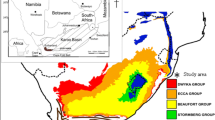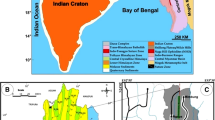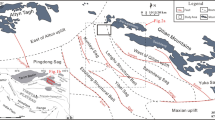Abstract
Rock-thin section study, scanning electron microscopy (SEM), X-ray diffraction (XRD), and Rock-Eval pyrolysis have been carried out on the Barail (Oligocene) and Disang (Eocene) groups of rocks of the Naga Schuppen Belt of Assam-Arakan Basin to understand the reservoir properties and hydrocarbon source potential. Analyses show that the Barail Group sandstones are moderately well-sorted, medium-grained, sublithic arenite type, and bear good porosity (avg. 14.48%). In contrast, the Disang Group sandstones are very hard and compact, fine-grained, sublihic arenite, and lithic greywacke types and show medium porosity (avg. 11.3%). The reservoir properties of the sandstones of both groups are controlled by various diagenetic alterations like mechanical compaction, cementation, overgrowth, authigenesis of clay, fracturing, dissolution, and alteration of unstable clastic grains. However, no single diagenetic process could be considered as the main controlling parameter in the evolution of the porosity of the studied sandstones. The Rock-Eval pyrolysis indicates that the carbonaceous shales of both the Barail and Disang groups are characterized by type III and type IV kerogen. A good number of shale samples show TOC (total organic carbon) values ranging from 0.88 to 10.71 wt% which seems quite good. In most of the samples, S2 is recorded <2 mg HC/g of rock, indicating the potential to generate wet gas. The various binary plots mostly show the gas source potential of shales of both the Barail and Disang groups. Production Index (PI) values vary between 0.04–0.45 for the Barail shales and 0.04–1.0 for the Disang shales, indicating that the studied shale samples are in the last phase of catagenesis.
Similar content being viewed by others
References
Al-Matary, A.M., Hakimi, M.H., Al-Sofi, S., Al-Nehmi, Y.A., Al-Haj, M.A., Al-Hmdani, Y.A. and Al-Sarhi, A.A. (2018) Preliminary Source Rock Evaluation and Hydrocarbon Generation Potential of the Early Cretaceous Subsurface Shales from Shabwah Sub-Basin in the Sabatayn Basin, Western Yemen. Journal of African Earth Sciences., v.142(March), pp.12–21. doi:https://doi.org/10.1016/j.jafrearsci.2018.02.009
Bharali, B. and Borgohain, P. (2013) Few Characteristics of Tipam Sandstone Formation within Oilfield Areas of Upper Assam - A Study Based on Wireline log data. Jour. Earth Sci.., Spec. Vol., pp.36–45.
Bhuyan, D., Borgohain, P. and Bezbaruah, D. (2022) Diagenesis and Reservoir Quality of Oligocene Barail Group of Upper Assam Shelf, Assam and Assam Arakan basin, India. Jour. Asian Earth Sci., v. 7, pp.1–13, doi:https://doi.org/10.1016/j.jaesx.2022.100100
Borgohain, K., Borgohain, P., Bharali, B. and Baruah, J. (2019) Sedimentological characteristics of the barail arenaceous unit of makum-north Hapjan oil field, Assam. Internat. Jour. Earth Sci. Geol., v.1(2), pp.66–73.
Borgohain, P., Bezbaruah, D., Gogoi, M. P., Gogoi, Y. K., Phukan, P. P., and Bhuyan, D. (2021) Petrography and diagenetic evolution of the Barail sandstones of Naga Schuppen Belt, North East India: implication towards reservoir quality. Curr. Sci., v.121(8), pp.1107–1113, doi:https://doi.org/10.18520/cs/v121/i8/1107-1113.
Borgohain, P., Borah, C. and Gilfellon, G.B. (2010) Sandstone Diagenesis and Its Impact on Reservoir Quality of the Arenaceous Unit of Barail Group of an Oilfield of Upper Assam Shelf, India. Curr. Sci., v.98(1), pp.82–88.
Borgohain, P., Hussain, M.F., Bezbaruah, D., Vanthangliana, V., Phukan, P.P., Gogoi, M.P. and Bharali, B. (2020) Petrography and whole-rock geochemistry of Oligocene Barail Sandstones of Surma basin: Implications for tectono-provenance and paleoclimatic condition. Jour. Earth Syst. Sci., v.129(1), pp.1–26, doi:https://doi.org/10.1007/s12040-020-01431-y
Boyer, C, Kieschnick, J., Suarez-Rivera, R., Lewis, R.E. and Waters, G. (2006) Producing Gas from Its Source. Oilfield Rev., v.18(3), pp.36–49.
Dickinson, W. R. (1985) Interpreting provenance relations from detrital modes of sandstones. In: Zuffa, G.G. (Ed.) Provenance of Arenites: NATO ASI Series (Series C: Mathematical and Physical Sciences). Springer, Dordrecht., v.148, pp.333–361, doi:https://doi.org/10.1007/978-94-017-2809-6_15
Dickinson, W. R., Beard, L.S., Brakenride, G.R., Erjavec, J.L., Ferguson, R.C., Inman, K. F., Knepp, R.A., Lindberg, F.A. and Ryberg, P.T. (1983) Provenance of North American Phanerozoic sandstones in relation to tectonic setting. Geol. Soc. Amer. Bull., v.94, pp.222–235.
Dickinson, W.R. and Suczek, C.A. (1979) Plate tectonics and sandstone compositions. AAPG Bull., v.63(12), pp.2164–2182, doi:https://doi.org/10.1306/2F9188FB-16CE-11D7-8645000102C1865D
Dickinson, W.R. (1970) Interpreting Detrital Modes of Graywacke and Arkose. Jour. Sediment. Petrol., v. 40(2), pp.695–707, doi:https://doi.org/10.1306/74D72018-2B21-11D7-8648000102C1865D
Ejedawe, J.E. (1986) The expulsion criterion in the evaluation of the petroleum source beds of the Teritary, Niger Delta. Jour. Petrol. Geol., v.9(4), pp.439–450. doi:https://doi.org/10.1111/j.1747-5457.1986.tb00404.x
Espitalie, J., Deroo, G. and Marquis, F. (1985) Rock-eval pyrolysis and its applications (Part-II). Revue Institut Français du Petrole., v. 40(6), pp.755–784, doi:https://doi.org/10.2516/ogst:1985045
Espitalie, J., Laporte, L., Madec, M., Marquis, F., Leplate, P., Pault, J. and Boutefeu, A. (1977) Methode rapid de caracterisation des rocks meres, deleur potential petrolier et leurdegre devolution. Rev. French Petrol. Instit., v.32, pp.23–42, doi:https://doi.org/10.2516/OGST:1977002
Espitalie, J., Marquis, F. and Barsony, I. (1984) Geochemical logging. In: Voorhees, K.J. (Ed.), Analytical pyrolysis: Techniques and application, London, Butterworths., pp.276–304, doi:https://doi.org/10.1016/B978-0-408-01417-5.50013-5
Gambhir, S.C., Nayak, S. and Mahanti, S. (1991) Problem well analysis of Upper Assam Oilfields of ONGC. Proceeding volume on Hydrocarbon deposit of North East India. All Assam Geological Forum, Gauhati University, Assam (India).
Gazzi, P. (1966) Le Arenarie del Flysch Sopracretaceo dell’Appennino Modenese, Correlazioni con il Flysch di Monghidoro. Mineralogica e Petrografica Acta., v.12, pp.69–97.
Ghori, K.A.R. and Haines P.W. (2007) Paleozoic Petroleum Systems of the Canning Basin, Western Australia: A Review. Search and Discovery Article #10120.
Hunt, J.M. (1979) Petroleum Geochemistry and Geology. W.H. Freeman and Co Ltd., 743p.
Jackson, K.S., Hawkins, P.J., Bennett, A.J.R. (1985) Regional facies and geochemical, evaluation of southern Denison Trough. Jour. Australian Petrol. Prod. Explor. Assoc. (APPEA)., v.20, pp.143–158.
Jones, R.W. and Demaison, G.J. (1982) Organic facies-Stratigraphic concept and exploration tool. Proceedings of the Second ASCOPE Conference and Exhibition, Manilla. Asean Council on Petroleum., pp.51–68.
Kent, W.N., Hickman, R.G. and Dasgupta, U. (2002) Application of a ramp/flatfault model to interpretation of the Naga thrust and possible implications for petroleum exploration along the Naga thrust front. AAPG Bull., v.86(12), pp.2023–2045, doi:https://doi.org/10.1306/61EEDDF0-173E-11D7-8645000102C1865D
Langford, F.F. and Blanc-Valleron, M.-M. (1990) Interpreting Rock-Eval Pyrolysis Data Using Graphs of Pyrolizable Hydrocarbons vs. Total Organic Carbon. Bull. AAPG, v.74(6), pp.799–804.
Mathur, L.P. and Evan, P. (1964) Oil in India. International Geological Congress. 22nd Session India., 85p.
Pahari, S., Singh, H., Prasad, I.V.S.V. and Singh, R.R. (2008) Petroleum Systems of Upper Assam Shelf, India. Geohorizons, December, pp.14–21.
Peters, K.E. (1986) Guidelines for Evaluating Petroleum Source Rock Using Programmed Pyrolysis. AAPG Bull., v.70(3), pp.318–329, doi:https://doi.org/10.1306/94885688-1704-11D7-8645000102C1865D
Peters, K.E. and Cassa, M.R. (1994) Applied Source Rock Geochemistry, In: Magoon, L.B. and Dow, W.G. (Eds.), The Petroleum System-From Source to Trap. AAPG Mem., v.60, pp.93–120, doi:https://doi.org/10.1306/M60585
Pettijohn, F.J., Potter, P.E. and Siever, R. (1972) Sand and Sandstones. Springer-Verlag, New York., 618p.
Rath, J.B., Sarma, J.N. and Borgohain, P. (2011) Remaining Oil Potential Based on 3-D Geological Model, TS-2 Sand, Lakwa Field, Upper Assam Basin, India. ONGC Bull., v. 46(1), pp.25–33.
Tissot, B.P., Pelet R. and Ungere, P.H. (1987) Thermal history of sedimentary basins, maturation indices, and kinetics of oil and gas generation. Bull. AAPG, v.71(12), pp.1445–1466, doi:https://doi.org/10.1306/703C80E7-1707-11D7-8645000102C1865D
Van Krevelen, D. W. (1950) Graphical-Statistical Method for the Study of Structure and Reaction Processes of Coal. Fuel., v.29, pp.269–284.
Acknowledgement
The authors are thankful to the Centre of Excellence for Energy Studies (CoEES) of Oil India Limited, Guwahati, for extending laboratory facilities for the Rock-Eval analysis. The authors are also grateful to the SAIF, Guwahati University, Assam, India, for providing laboratory facilities to conduct the XRD analysis.
Author information
Authors and Affiliations
Corresponding author
Rights and permissions
About this article
Cite this article
Gogoi, M.P., Borgohain, P., Gogoi, Y.K. et al. Petrography, Diagenesis and Hydrocarbon Source Potential of the Barail and Disang Group of Rocks in Parts of the Naga Schuppen Belt and Inner Fold Belt of Assam-Arakan Basin. J Geol Soc India 99, 906–916 (2023). https://doi.org/10.1007/s12594-023-2412-z
Received:
Accepted:
Published:
Issue Date:
DOI: https://doi.org/10.1007/s12594-023-2412-z




